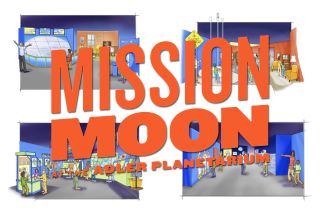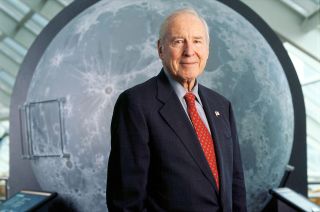Planetarium's Apollo 13 Astronaut Exhibit to Get Crowdfunded Redesign

America's first planetarium wants to better share the story of the United States' first steps into space and the career of one of the country's most famous astronauts — and needs your help to do it.
The Adler Planetarium in Chicago, established in 1930, is redesigning its almost decade-old exhibition "Shoot for the Moon" and re-launching it as "Mission Moon" to immerse visitors in the life of astronaut James Lovell. The debut of the re-imagined exhibit is timed to coincide with the 45th anniversary of Lovell's best-known mission, Apollo 13.
"Since 2006 we've been telling the story of Captain James Lovell, an astronaut who flew on Gemini 7, Gemini 12, Apollo 8 and Apollo 13 but we want to tell that story a little better," Michelle Nichols, a master educator in the Adler's astronomy department, said in a video statement. [Apollo Quiz: Test Your Moon Landing Memory]
To achieve that, the Adler on Monday (Jan. 19) launched its first crowdfunding campaign, aiming to raise $95,000 to support the opening of the "Mission Moon" exhibit on April 11, 45 years to the day after the launch of Apollo 13. The campaign, hosted by Indiegogo.com, is set to run through March 20.
"When you donate," Nichols said, "you are helping support the Adler Planetarium's mission to inspire exploration and understanding of our universe."
Stepping into space history
In the Adler's previous "Shoot for the Moon" exhibit, which opened in 2006 and closed on Jan. 5 this year, visitors got a first look at many of Lovell's personal space mementos and at one of the space capsules that he flew aboard.
In the new "Mission Moon," museum-goers will step into Lovell's life events to experience the moments that made space history. Through hands-on activities, visitors will be able to build and launch a rocket, monitor astronaut vitals from Mission Control and help engineer a solution to keep the Apollo astronauts safe and healthy in space.
Get the Space.com Newsletter
Breaking space news, the latest updates on rocket launches, skywatching events and more!
"At every point in the new exhibition, Lovell is there," the museum's website describes, from his being rejected from NASA's Mercury program in the late 1950s, to his Gemini missions in the 1960s, to the successful failure of Apollo 13. Alongside Lovell, "Mission Moon" shares the stories of the astronaut's family, NASA's mission control, and others from around the world whose participation made the moon landings possible.
"The centerpiece of the gallery experience [remains] the Gemini 12 capsule," Nichols described, "a real spacecraft that after four days in space safely returned [crewmates] Jim Lovell and Buzz Aldrin to Earth."
As part of the re-imagining of the exhibition, the Adler is building a ramp around the capsule's protective glass case to give visitors of all heights and abilities a better vantage point at the realities of living and working in space in the mid-20th century.
Lovell leads the way
The Adler's Mission Moon crowdfunding campaign invites donations from $5 to $20,000. The names of all donors will be included on a virtual "Wall of Thanks," to be hosted on the planetarium's website.
For the highest level of support, two parties of 10 will have the chance to tour the new exhibition with its inspiration as their guide. The real James Lovell will lead the donors and their guests through "Mission Moon" during its opening in April.

Only two private tours are being offered.
For everyone else, the Adler is offering a number of other perks, ranging from packages of astronaut freeze-dried ice cream to official "Mission Moon" apparel and tote bags to invitations to the exhibit's launch.
The Adler has also commissioned an original painting by nationally-acclaimed artist Michael Birawer. Twenty (20) donors at the $2,500 level will receive high-quality prints of the artwork, signed and numbered by the artist. Or for a $500 donation, the museum is offering a poster version of the art, signed by Lovell.
At all levels of support, participants will be helping make the "Mission Moon" exhibition possible.
"Help us create a unique, shared experience that tells our story through the lives of the exceptional individuals who made history," Marc Lapides, the Adler's vice president of business and market development, said.
Click through to collectSPACE to watch a video about the Adler's "Mission Moon" exhibit.
Follow collectSPACE.com on Facebook and on Twitter at @collectSPACE. Copyright 2015 collectSPACE.com. All rights reserved.
Join our Space Forums to keep talking space on the latest missions, night sky and more! And if you have a news tip, correction or comment, let us know at: community@space.com.

Robert Pearlman is a space historian, journalist and the founder and editor of collectSPACE.com, an online publication and community devoted to space history with a particular focus on how and where space exploration intersects with pop culture. Pearlman is also a contributing writer for Space.com and co-author of "Space Stations: The Art, Science, and Reality of Working in Space” published by Smithsonian Books in 2018. He previously developed online content for the National Space Society and Apollo 11 moonwalker Buzz Aldrin, helped establish the space tourism company Space Adventures and currently serves on the History Committee of the American Astronautical Society, the advisory committee for The Mars Generation and leadership board of For All Moonkind. In 2009, he was inducted into the U.S. Space Camp Hall of Fame in Huntsville, Alabama. In 2021, he was honored by the American Astronautical Society with the Ordway Award for Sustained Excellence in Spaceflight History.
Most Popular


